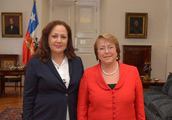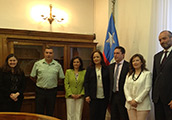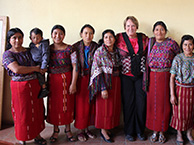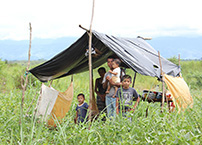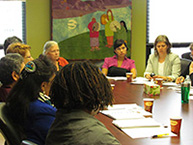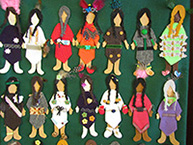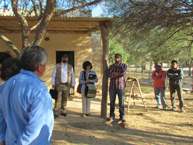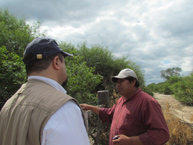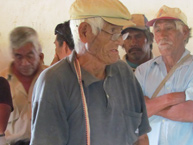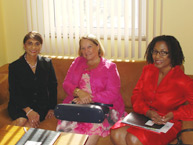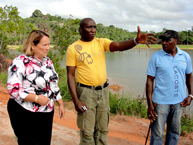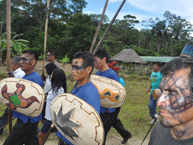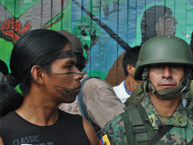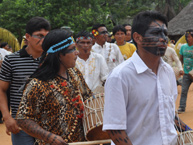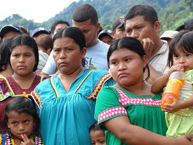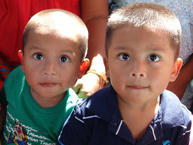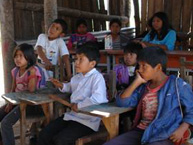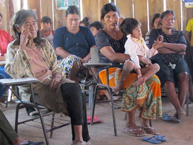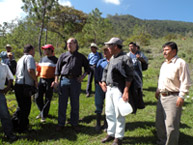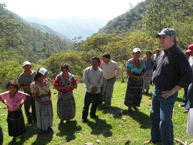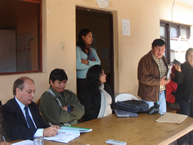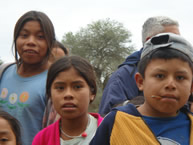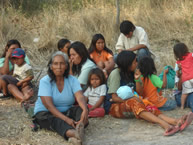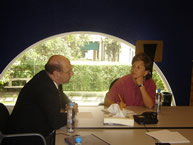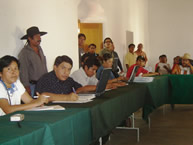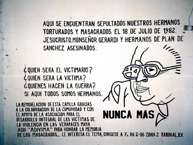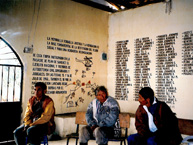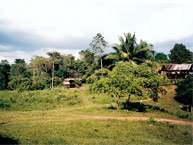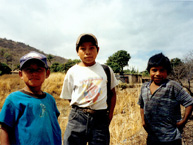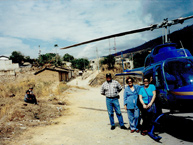- English
- Español
Indigenous Peoples
Country Visits
Chile, November 24-26, 2014
The Rapporteur on the Rights on Indigenous Peoples and Rapporteur for Chile, Commissioner Rose-Marie Belle Antoine, undertook a visit to Chile between November 24 and 26, 2014. The main objective of the visit was to collect information on the general situation of human rights in the country, as well as closely examine the human rights situation of indigenous peoples in this country, in particular in the context of development and investment projects, and concessions for the extraction of natural resources.
During the visit, the Rapporteur was received by the President of the Republic, Michelle Bachelet, among other authorities. The visit also included meetings with civil society organizations, and working meetings related to individual cases to follow up on the compliance of the State in relation to recommendations of the IACHR.
Guatemala – August 21 to 30, 2013
The Office of the Rapporteur on the Rights of Indigenous Peoples of the IACHR carried out a working visit to Guatemala on August 21-30, 2013. The visit aimed to gather information on the situation of indigenous peoples in Guatemala, with special emphasis on the discrimination and exclusion experienced by indigenous peoples, as well as the situation involving their lands, territories, and natural resources and their right to prior, free, and informed consultation. The delegation was led by the IACHR Rapporteur on the Rights of Indigenous Peoples, Commissioner Dinah Shelton.
“We were able to substantiate that racism and discrimination against indigenous peoples persists in Guatemala, but also that the government has initiated several new programs intended to address this situation. Unfortunately, disproportionate rates of poverty, extreme poverty, and child malnutrition, persist among the rural indigenous population” Rapporteur Dinah Shelton said. “It is also of concern that the current licenses for mining and hydroelectric plants were granted without the State having implemented prior, free, and informed consultation with affected indigenous communities, as it is obligated to do under international treaties signed by Guatemala,” she added.
- Press Release issued after the visit
- Flickr Photo Galleries on the Visit to Guatemala: Cobán; El Rodeo, Valle del Polochic; Agua Caliente, Valle del Polochic; San Marcos; Totonicapán; Huehuetenango; Nebaj; Experts Meeting; Training Workshop; Visit to Guatemala
Canada – August 6-9, 2013
The Inter-American Commission on Human Rights carried out a working visit to Canada on August 6-9, 2013, to look into the disappearances and murders of indigenous women in British Columbia. The delegation was made up of Commissioner Dinah Shelton, Rapporteur on the Rights of Indigenous Peoples; Commissioner Tracy Robinson, First Vice Chair of the IACHR and Rapporteur on the Rights of Women; and staff of the Executive Secretariat. The visit began in Ottawa and continued in British Columbia, specifically in Vancouver and Prince George. The delegation received information and testimony from relatives of indigenous girls and women who have disappeared or have been killed. In Ottawa, the delegation met with federal government authorities and civil society organizations and representatives, including tribal organizations and leaders. In British Columbia, the delegation met with provincial government authorities, representatives of the legislative branch, and civil society organizations and representatives, including tribal organizations, authorities, and leaders.
Argentina - Lhaka Honhat - May 9-13, 2013
A delegation of the Executive Secretariat of the IACHR made a visit to Argentina from May 9 to13, 2013. The goal was to prepare a diagnostic on the compliance with the recommendations that the IACHR included in Merits Report 2/12 on the case of the Indigenous Communities members of the Association Lhaka Honhat of Argentina, approved on January 26, 2012. The delegation held meetings in the city of Salta with representatives of the Government of the Salta Province. It also visited the municipality of Santa Victoria del Este, to meet with indigenous leaders of the Lhaka Honhat Association, and to visit the indigenous territory. It also held meetings in Buenos Aires with authorities of the National Government. The parties expressed that the visit enabled an opportunity to open a dialogue and incentivate the compliance of the recommendation by the Argentine State.
Suriname - January 23 to 25, 2013
The Inter-American Commission on Human Rights undertook a working visit to the Republic of Suriname between January 23-25, 2013 in order to examine the situation of the rights of women and indigenous peoples. The delegation was composed of Commissioner Dinah Shelton, Rapporteur on the Rights of Indigenous Peoples; Commissioner Tracy Robinson, First Vice-President and Rapporteur on the Rights of Women; and staff from the Executive Secretariat.
During the visit, the delegation held meetings with the highest authorities of the Suriname state, and representatives from civil society organizations dedicated to the defense of the rights of indigenous peoples, women and LGBTI persons in the country. Several members of the delegation also traveled to the district of Brokopondo and the village of Brownsweg to visit a Maroon village composed of 8,000 persons. The delegation offered in a workshop attended by approximately fifty government officials on the Inter-American System of Human Rights and an academic event at the Anton de Kom University, with the participation of law professors and students.
Colombia, December 3 to 7, 2012
A specialist of the Rapporteurship participated in the in loco visit conducted by the IACHR to Colombia on December 3 to 7, 2012, to collect specific information on the human rights situation of indigenous peopls in the country. During the visit, information was received in the meetings held in Bogota with State authorities, as well as in specific meetings on the situation of indigenous peoples. In addition, considering that the situation of indigenous peoples in the Cauca Department generates special concern to the IACHR and to the Rapporteurship, a subgroup traveled to Popayán, Cauca, where it met with organizatons and indigenous authorities, as well as with regional State authorities.
Kichwa People of Sarayaku, Ecuador's Amazon Region, April 21, 2012
On April 21, 2012, an IACHR delegation accompanied a visit made by the Inter-American Court of Human Rights to the territory of the Kichwa people of Sarayaku, in Ecuador's Amazon region. The purpose of the visit was to conduct “proceedings aimed at obtaining additional information about the situation of the...victims and places where some of the alleged events took place” in a case before the Inter-American Court. In addition to staff from the Inter-American Commission, other participants in the visit included representatives of the victims and of the State. The delegation heard statements from many members of the Kichwa people, including elders, children, and young people. Through its Office of the Rapporteur on the Rights of Indigenous Peoples, the IACHR reiterated the reasons it had taken the case to the Court—in particular, the right of indigenous peoples to prior consultation that is free and informed.
During the visit, the coordinator for the Office of the Rapporteur on the Rights of Indigenous Peoples, Isabel Madariaga, made the following remarks:
The IACHR delegation thanks Sarayaku. The Commission presented this case to the Court because the Ecuadorian State allowed an oil company to carry out activities in the Sarayaku territory without a prior, free, and informed consultation. The State did not obtain consent from the Sarayaku people; rather, the State caused fear and irreparably damaged the Sarayaku territory. Instead of sowing life, it sowed explosives, it sowed death. It militarized the territory, threatened and harassed its people, damaged community communications, and showed disrespect toward the Sarayaku people.
The community had to defend what the State itself did not recognize: its territory. When constitutions and laws talk about the rights of indigenous peoples, when the Court determines that indigenous peoples have the right to live freely in their own territory, we see that this is precisely what Sarayaku is demanding.
The Sarayaku people want to live freely in their own territory, and freedom also means that the people of Sarayaku are the ones who will decide what types of projects will be implemented and who will enter. For Sarayaku, territory is life; they depend on their territory, and that is precisely what the Commission is defending.
Guatemala, March 7 to 10, 2012
Rapporteur Dinah Shelton made a working visit to Guatemala from March 7 to 10, 2012, in order to collect information on the situation of human rights, with special emphasis on the situation of indigenous peoples. To that end, Commissioner Shelton's met representatives of the state, international agencies, civil society, and indigenous peoples. Accompanying her on the visit were the the IACHR coordinator for the Mesoamerica Region and for the Office of the Rapporteur on Indigenous Peoples, Isabel Madariaga; the attorney for the Mesoamerica Region, Fiorella Melzi; and the attorney for the Office of the Rapporteur on the Rights of Indigenous Peoples, Cristina Blanco.
Paraguay, August 1 to 5, 2011
Between August 1-5, 2011, Dinah Shelton, Rapporteur for Indigenous Peoples carried out a working visit to Paraguay to conduct promotional activities, encourage compliance with the decisions of the Inter-American Commission on Human Rights and the Inter-American Court of Human Rights, and promote the use of the friendly settlement mechanism to resolve petitions and cases being processed by the IACHR. The delegation also took the opportunity to further its understanding of the human rights situation in Paraguay. To that end, the Commission met with high-level authorities of the various branches of government, as well as with representatives of civil society organizations. The visit also included a significant number of working meetings between parties with regard to petitions and cases pending before the IACHR, in which major progress was made.
Panama, December 2010
On December 14-19, 2010, Rapporteur Dinah Shelton carried out a fact-gathering visit to Panama in connection with the case of the Kuna of Madungandí and Embera of Bayano indigenous communities, and the case of the Ngöbe communities located in the area where the Chan 75 Dam is being built on the Changuinola River. During the visit, the Rapporteur met with government officials and traveled to the various communities involved in these cases. Attorneys Federico Guzmán and Lilly Ching also participated in the visit.
Paraguay, September 2010
On September 3-7, 2010, Rapporteur Dinah Shelton conducted a working visit to Paraguay to visit indigenous communities that have cases before the inter-American human rights system and to obtain information regarding the general situation of indigenous peoples. The Rapporteur met with State officials and with representatives of indigenous organizations and organizations of human rights defenders. She visited the Yakye Axa, Sawhoyamaxa, and Kelyenmagategma indigenous communities of the Enxet-Sanapaná people, in the Chaco region, as well as the Y'aká Marangatú community of the Guaraní Mbya people, in the eastern region of the country. Federico Guzmán, the Office of the Rapporteur's attorney, also participated in the visit.
Guatemala, June 7-12, 2009
During a visit to Guatemala on June 7-12, 2009, the Rapporteur on the Rights of Indigenous Peoples, Commissioner Víctor Abramovich, attended working meetings on the implementation of certain precautionary measures, and on the cases of Maurilia Coc Max et al. (Xaman Massacre), Angélica Jerónimo Juárez, and Los Josefinos Massacre, among others. The delegation visited the community of Río Negro and traveled to Pacoxom, Pacux, and Rabinal to talk to relatives and survivors of the massacres suffered by their inhabitants. The IACHR delegation headed by Commissioner Abramovich also included human rights specialists Isabel Madariaga, Karla Quintana, and Fiorella Melzi.
Colombia, November 17-21, 2008
The Rapporteur on the Rights of Indigenous Peoples, Commissioner Víctor Abramovich, carried out a visit to Colombia on November 17-21, 2008. In a meeting with the National Indigenous Organization of Colombia (ONIC) and other indigenous organizations and leaders in the country, the Rapporteur received information on the impact of the armed conflict and other forms of violence on indigenous peoples, as well as on the precariousness of their socioeconomic situation.
Bolivia, June 9-13, 2008
The Office of the Rapporteur on the Rights of Indigenous Peoples participated in a working visit to Bolivia on June 9-13, 2008, to gather information on the situation of several communities of the Guaraní indigenous people suffering from conditions of servitude and forced labor analogous to slavery. The communities were located in the departments of Santa Cruz, Chuquisaca, and Tarija, in the Bolivian Chaco.
The IACHR delegation was led by Commissioner Víctor Abramovich, in his capacity as Rapporteur on the Rights of Indigenous Peoples, and Commissioner Luz Patricia Mejía, in her capacity as Rapporteur for Bolivia, and also included human rights specialists Débora Benchoam and Anexa Alfred and press director María Isabel Rivero. During the visit, various meetings were held with national and local State officials, nongovernmental organizations, international agencies, civil society, and indigenous organizations in La Paz, Sucre, Camiri, and Santa Cruz. The delegation also visited the community of Itacuatía, located in the Alto Parapetí region of Cordillera province, in the department of Santa Cruz. The information and testimony obtained during the visit confirmed that debt bondage and forced labor were continuing in the Bolivian Chaco, and that the situation of the Guaraní people in this region had worsened since the Commission's last visit in November 2006.
This visit arose as a result of the Memorandum of Commitment signed on March 11, 2008, at IACHR headquarters during the 131st period of sessions between the government of Bolivia, the Guaraní Captains Council of Chuquisaca, and civil society organizations. In the agreement, the State made a commitment to adopt the protection measures needed to safeguard the personal integrity of all the Guaraní families and their leaders and advisers. A commitment was also made to inform the Commission about the measures adopted and the progress made in the process of restoring lands to the Guaraní people.
The delegation observed that the situation of servitude and forced labor in which the Guaraní families live is an extreme manifestation of the discrimination that indigenous peoples and peasant communities have suffered historically and continue to suffer in Bolivia. Based on the material gathered during this visit, the IACHR produced the report Captive Communities: Situation of the Guaraní Indigenous People and Contemporary Forms of Slavery in the Bolivian Chaco, approved in December 2009 and published in 2010.
Paraguay, September 3-4, 2007
The Rapporteur on the Rights of Indigenous Peoples, Paolo Carozza, carried out a visit to Paraguay. The delegation also included human rights specialist Isabel Madariaga, press director María Isabel Rivero, and documentation specialist Gloria Hansen. Among the activities that took place, on September 3, 2007, the Rapporteur visited the Xákmok Kásek and Yakye Axa indigenous communities of the Enxet, Sanapaná, and Angaité peoples, in the Paraguayan Chaco.
Commissioner Carozza, accompanied by IACHR Chair Florentín Meléndez, also met with representatives of more than 300 indigenous communities of the Eastern and Western Regions of Paraguay. During the meeting, representatives of 14 indigenous associations explained the serious, urgent situation faced by their communities. They described the encounter as historic, because "for the first time they engaged in direct dialogue [with the IACHR], without intermediaries." In addition, on September 7, 2007, the Office of the Rapporteur met with a series of government officials in charge of policies having to do with indigenous peoples, and held working meetings on petitions and cases whose alleged victims are indigenous communities.
Peru - December 11-14, 2006
Commissioner Paolo Carozza, Rapporteur for Peru, along with IACHR Executive Secretary Santiago A. Canton and staff members of the Executive Secretariat, carried out a working visit to Lima on December 11-14, 2006. They met with President Alan García and other high-level government officials, as well as with a large number of civil society organizations, organizations of Afro-descendants, and indigenous organizations and communities. The delegation also met with academics and former members of the Truth and Reconciliation Committee.
Mexico - August 25-31, 2005
At the invitation of the Mexican government and at the request of several representatives of Mexican civil society, the Inter-American Commission visited Mexico on August 25-31, 2005. The delegation was composed of Commissioner José Zalaquett, Rapporteur on the Rights of Indigenous Peoples and Rapporteur for Mexico, as well as staff of the Executive Secretariat of the Commission.
In Mexico City, the IACHR held meetings with federal authorities, with the UN Special Rapporteur on the Situation of Human Rights and Fundamental Freedoms of Indigenous People, Rodolfo Stavenhagen, and with representatives of Mexican civil society. Meetings were also held on pending cases and petitions, and a meeting was held with a number of Mexican organizations that work to safeguard the rights of indigenous peoples.
On this occasion, the IACHR made its first official visit to the state of Oaxaca. It held meetings with representatives of Oaxacan civil society organizations and with technical staff of a United Nations project to implement recommendations stemming from a UN diagnosis of the human rights situation in Mexico, as well as with authorities, academics, and the State Human Rights Commission. Working meetings were also held in Oaxaca on precautionary measures and cases pending before the IACHR, as well as a meeting with the Secretary General of the Oaxaca state government. The visit gave the Commission valuable information about the problems that have given rise to agrarian, community, and political conflicts in the state of Oaxaca.
Guatemala, July 18-21, 2005
The First Vice-Chair of the IACHR and Rapporteur for Guatemala, Susana Villarán, visited Guatemala July 18-21, 2005, at the invitation of the government and at the request of civil society representatives, with financial support from the European Commission. In the course of her visit, the Commissioner met with the highest-level authorities of the State of Guatemala, as well as with victims, relatives of victims, and civil society organizations that safeguard and promote human rights in the country. In this context, working meetings were held on five cases in which important agreements had been reached on friendly settlement, five cases involving follow-up to recommendations, and eight involving precautionary measures.
The Commissioner attended an act of remembrance to publicly commemorate the victims of the Plan de Sánchez massacre. This massacre took place on July 18, 1982, when members of the Guatemalan army and civilian collaborators under the army's direction executed 268 individuals, most of them Maya indigenous people. During the ceremony, Commissioner Villarán welcomed the public recognition of the State's responsibility and the request for forgiveness. She said Guatemala's commitment to the inter-American system had been reinforced, opening the door for healing the community of Plan de Sánchez and taking steps to ensure that these types of human rights violations do not happen again.
During the visit, Commissioner Villarán also presented a document on compensation for victims of human rights violations; followed up on issues of the administration of justice and violence against women; and evaluated the situation of social leaders, indigenous people, justice workers, and human rights defenders. With respect to the administration of justice, Commissioner Villarán took note of information suggesting that there are serious gaps in interagency coordination, which in many cases prevent the institutions from working effectively and in a timely manner. She also indicated that none of the institutions that played a role in the administration of justice had the necessary human and financial resources to properly carry out its mandates.
At the end of her visit, the Commissioner noted with concern the increased level of violence and the persistence of serious shortcomings in the Guatemalan justice system, which heightened the feeling of insecurity among the population. She indicated that this situation was especially acute for indigenous leaders, social leaders, peasants, youth, and justice workers, who have been victims of threats and hostile acts. In this respect, Commissioner Villarám underscored the importance of strengthening institutional support and training in human rights through the adoption of a coordinated security policy by the various actors involved in the administration of justice in the country.
Nicaragua - February 2004
In February 2004, Commissioner Susana Villarán carried out a visit to the Awas Tingni community in Nicaragua. The aim of the visit was to follow up on the implementation of the judgment of the Inter-American Court in the Case of the Mayagna (Sumo) Awas Tingni Community, which ordered the demarcation and titling of its lands. The delegation met with State officials and with the community's legal representatives and traditional authorities, among others. In December 2008, the government of Nicaragua handed over to the Awas Tingni the property title to 73,000 hectares of its territory, marking a crticial step forward in the resolution of the first case involving indigenous peoples' collective ownership rights that the Commission had taken to the Court.
Colombia - June 17-27, 2003
Commissioner Robert K. Goldman, Rapporteur for Colombia, carried out a working visit to that country on June 17-27, 2003. During the course of his visit, the Commissioner held meetings with national and local officials, including the Vice President of Colombia, the Minister of Foreign Affairs, the Ministers of the Interior and of Justice, the Deputy Minister of Defense, the Attorney General, and the President of the Constitutional Court.
The IACHR delegation traveled to the departments of Antioquia, Córdoba, and Chocó, and took statements from various persons, representatives of the community and representatives of civil society organizations. The main purposes of the visit were to obtain in-depth information on the situation in Comuna 13, in the city of Medellín, and to verify compliance with the precautionary measures granted by the Commission for the indigenous community of Embera Katío and the Afro-Colombian communities of Cararica. During the visit, Commissioner Goldman called attention to the challenges facing the government of Colombia in its efforts to establish peace and demobilize members of illegal armed groups. In this context, he emphasized the State's obligation to refrain from adopting measures that would allow crimes against humanity and other serious violations of international humanitarian law to go unpunished.
Guatemala - March 24-29, 2003
At the invitation of the Guatemalan government, the Commission carried out a visit to Guatemala March 24-29, 2003. The IACHR delegation for that visit was composed of the Commission's First Vice-Chair, José Zalaquett; the Second Vice-Chair, Clare Roberts; the Rapporteur for Guatemala, Commissioner Susana Villarán; Commissioners Juan E. Méndez and Julio Prado Vallejo; Executive Secretary Santiago A. Canton; the Special Rapporteur for Freedom of Expression, Eduardo Bertoni; and human rights specialists María Claudia Pulido, Elizabeth Abi-Mershed, Isabel Madariaga, Andrea Galindo, and Tamara Taraciuk.
During the visit, the IACHR met with authorities from the different branches of government and with civil society representatives, including representatives of organizations of indigenous peoples' rights. The IACHR also heard testimony from victims of human rights violations and received information and testimony on the situation in all regions of the country. An IACHR delegation traveled to Nebaj, in the department of El Quiché.
The information and testimony gathered during this visit were included in the report Justice and Social Inclusion: The Challenges of Democracy in Guatemala (available only in Spanish), which was approved on December 29, 2003. Chapter IV of that report is devoted entirely to the situation of indigenous peoples.
Paraguay - July 28-30, 1999
The Office of the Rapporteur on the Rights of Indigenous Peoples visited the indigenous communities of Yakye Axa and Sawhoyamaxa, as part of an onsite visit the IACHR made to Paraguay on July 28-30, 1999.
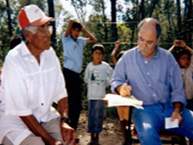
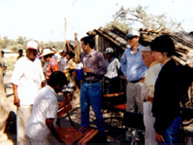
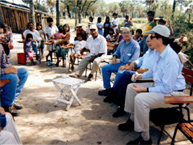
A Commission delegation led by the Rapporteur on the Rights of Indigenous Peoples, Carlos Ayala Corao, traveled to the Pozo Colorado district in the department of Presidente Hayes, in the Paraguayan Chaco, to meet with the Yakye Axa and Sawhoyamaxa indigenous communities of the Enxet-Lengua people. There, the delegation learned about the deplorable situation being experienced by the members of these communities, who were living alongside the national highway, without any services of any kind, waiting for the appropriate agencies to assign them the lands they needed. The Commission at that time praised the importance of Presidential Decree No. 3789, dated June 23, 1999, which declared a "state of emergency" for these indigenous communities, due to the extreme circumstances in which they were living. However, the Commission was told by members of the indigenous communities that the appropriate agencies had not adopted the effective measures ordered by the Executive Decree to provide immediate medical attention and food to the families that make up these communities.
With regard to the Case of the Yakye Axa Community, on March 17, 2003, the IACHR filed an application with the Inter-American Court, which issued a judgment on the merits of the case on June 17, 2005, and an interpretation of the judgment on February 6, 2006. With regard to the Case of the Sawhoyamaxa Community, the Inter-American Court handed down a judgment on March 29, 2006, and an order monitoring compliance with that judgment on February 8, 2008.
During the 1999 visit, the IACHR also visited the Lamenxay and Riachito (Kayleyphapopyet) indigenous communities, both of which belong to the Enxet-Sanapaná people, in the context of a petition involving claims to rights over their ancestral territories. The petition was lodged by the organization Tierra Viva, with assistance from the Center for Justice and International Law (CEJIL). On March 25, 1998, the parties signed a friendly settlement agreement, promoted by the IACHR, under which the State committed to purchase an area of 21,844.44 hectares located in the Pozo Colorado district, department of Presidente Hayes, in the Paraguayan Chaco; hand it over to the aforesaid indigenous communities; and register it with the competent authorities as belonging to these communities. The Paraguayan State had already complied with its commitment to acquire these lands and turn them over to the indigenous communities, but title over the land had not yet been transferred. During the onsite visit, in a meeting with Paraguayan President Luis Angel González Macchi, the Commission was informed that on July 27, 1999, the State had issued title deeds to the land in question in the names of these communities, thus complying with all the commitments it had assumed. On that occasion, in the presence of the IACHR, the President of the Republic presented the title deeds to representatives of the indigenous communities. On September 29, 1999, the IACHR approved its Friendly Settlement Report 90/99 on this case.
Following the visit, a report was prepared, and it was approved by the Commission on March 9, 2001. Chapter IX is about the situation of indigenous peoples.
Guatemala - August 6-11, 1998
The Commission, at the invitation of the Guatemalan government, carried out an onsite visit to Guatemala on August 6-11, 1998, to analyze the general human rights situation in that country. The IACHR delegation was composed of the Chair of the Commission, Carlos Ayala Corao; Commissioners Claudio Grossman and Hélio Bicudo; Executive Secretary Jorge Taiana; Assistant Executive Secretary David Padilla; and human rights specialists Elizabeth Abi-Mershed, Osvaldo Kreimer, and Verónica Gómez.
The IACHR met with the President of Guatemala, Alvaro Arzú Irigoyen. Meetings were also held with other high-level authorities of the government and the legislative and judicial branches of the State of Guatemala, as well as with nongovernmental human rights organizations, social and business organizations, representatives of indigenous communities, journalists, alleged victims of human rights violations, the Commission for Historical Clarification, the United Nations Verification Mission in Guatemala, and international organizations with offices in Guatemala. The Commission also visited several detention centers. It traveled to Nebaj and Quetzaltenango, where it met with local officials and representatives of indigenous communities. The observations it made during this visit were reflected in the Fifth Report on the Situation of Human Rights in Guatemala.
Colombia - December 1-8, 1997
At the invitation of the government of Colombia, the IACHR carried out an onsite visit to that country on December 1-8, 1997. Participants in the visit included the Chair of the IACHR, John S. Donaldson; the First Vice-Chair, Carlos M. Ayala Corao; the Second Vice-Chair, Robert K. Goldman; and Commissioners Oscar Luján Fappiano, Claudio Grossman, and Jean Joseph Exumé. Commissioner-elect Hélio Bicudo also participated as an adviser. The delegation was also composed of Executive Secretary Jorge E. Taiana, Assistant Executive Secretary David J. Padilla, and human rights specialists Osvaldo Kreimer, Denise Gilman, and Mario López-Garelli.
During the course of its visit, the IACHR traveled to various places, including Santafé de Bogotá, Medellín, Urabá, Puerto Asís, and Villavicencio. The Commission also visited the territory of the Uwa indigenous people in Boyacá. The information received was processed and analyzed in the Third Report on the Human Rights Situation in Colombia.
Guatemala, March 4-11, 1994
Visit to Communities of Peoples in Resistance
The IACHR visited Guatemala March 4-11, 1994, in order to observe the process of resettlement and restoration of normal life of the so-called Communities of Peoples in Resistance in the department of El Quiché. The delegation was comprised of the Second Vice-Chair of the IACHR, Leo Valladares Lanza; the Assistant Executive Secretary, David Padilla; and human rights specialists Osvaldo Kreimer and Elizabeth Houppert.
During the visit, the delegation contacted various national authorities and representative of the so-called Communities of Peoples in Resistance. It visited settlements in Ixcán and the highlands of El Quiché, and observed the human rights situation of the various sectors. The Commission adopted a special report as a result of that visit.
Guatemala - September 6-10, 1993
The Commission carried out an observation visit to Guatemala on September 6-10, 1993. The delegation was made up of the Chair of the Commission, Oscar Luján Fappiano; the First Vice-Chair, Michael Reisman; the Second Vice-Chair, Alvaro Tirado Mejía; Commissioners Marco Tulio Bruni Celli, Oliver Jackman, and Leo Valladares Lanza; the Executive Secretary, Edith Márquez Rodríguez; the Assistant Executive Secretary, David J. Padilla; and human rights specialist Osvaldo Kreimer, a lawyer from the Secretariat.
The Commission met with President Ramiro de León Carpio and various ministers; the President of the Constitutional Court, Epaminondas González; the President of the Supreme Court of Justice, Juan José Rodil Peralta; the Human Rights Prosecutor, Jorge Mario García Laguardia; and the Chair of the Presidential Commission on Human Rights (COPREDEH), Jorge Cabrera Ugarte, among other authorities. Meetings were also held with human rights institutions and organizations, and the Commission met with individuals and members of institutions representative of Guatemalan society, religious groups, peasants, indigenous people, refugees, individuals who had been displaced or returned, trade union members, students, and members of the Communities of Peoples in Resistance, among others.
The Commission traveled to the interior of the country, to areas in the departments of El Quiché and Huehuetenango, where it met with members of the so-called Civilian Self-Defense Patrols (PACs), military authorities, and individuals interested in discussing their situation and sharing their thoughts with respect to the human rights situation in the region. In Huehuetenango, the IACHR visited Colotenango and neighboring communities, such as La Cumbre and Granadillos; in El Quiché, it visited Santa Cruz.
Guatemala - November 2-6, 1992
The Commission carried out a visit to Guatemala on November 2-6, 1992. Participants included the Chair of the IACHR, Marco Tulio Bruni Celli, and Commissioners Leo Valladares Lanza, Patrick L. Robinson, and Álvaro Tirado Mejía, along with staff members of the Executive Secretariat. During this visit, the Commission learned about relevant aspects of the complex and sensitive human rights situation Guatemala was going through. The information gathered was used to prepare the Fourth Report on the Situation of Human Rights in Guatemala, published on June 1, 1993. Chapter II of the report, The Guatemalan Maya-Quiché Population and their Human Rights, and Chapter VIII, Communities of Peoples in Resistance, contain information about the human rights situation of indigenous peoples in Guatemala.
Nicaragua - May 3-6, 1982
Onsite Observation of the Situation regarding the Miskito Indigenous People of Nicaragua's Atlantic Region
The IACHR carried out a visit May 3-6, 1982, to learn firsthand about the situation involving new settlements of ethnic minorities along the Atlantic Coast. The delegation was composed of the President of the IACHR, Tom J. Farer, and Commissioners César Sepúlveda and Luis Demetrio Tinoco. During its time in Nicaragua, the Commission visited the “Héroes y Mártires de Nueva Guinea” prison in Managua, formerly called the "Zona Franca" prison; the detention center of the Seventh Military Region of Puerto Cabezas, in the department of Zelaya; and the new indigenous settlements of Sahsa and Sumubila.
The IACHR met with members of the Directorate of the Government of National Reconstruction; the National Commission for the Promotion and Protection of Human Rights; the Permanent Human Rights Commission; the Ministry of the Interior; officials from the Nicaraguan Institute for the Atlantic Coast (INNICA); members of the Supreme Court of Justice and of the Bluefields Court of Appeals; and other civilian and military authorities and individuals, both at the national and departmental level.
Meetings were also held with the head of the Conference of Bishops of Bluefields and with representatives of various religious, humanitarian, and professional institutions in the country. During the visit to the new settlements of Sahsa and Sumubila, interviews were held with members of the indigenous communities.
At the end of its visit, the IACHR gave the Government of National Reconstruction a document with preliminary recommendations it considered urgent to put into practice in order to improve the human rights situation of those ethnic groups. On November 29, 1983, the IACHR approved the Report on the Situation of Human Rights of a Segment of the Nicaraguan Population of Miskito Origin.
Honduras -May 7-10, 1982
At the end of the Commission's visit to Nicaragua, a delegation headed by Luis Demetrio Tinoco Castro traveled to Honduras for a visit May 7-9, 1982, to Tegucigalpa, Puerto Lempira, and the Nicaraguan Miskito refugee camp located in Mocoró, on the border with Nicaragua. The delegation received statements and testimony from the Nicaraguan Miskito groups that had taken refuge in Honduras.


